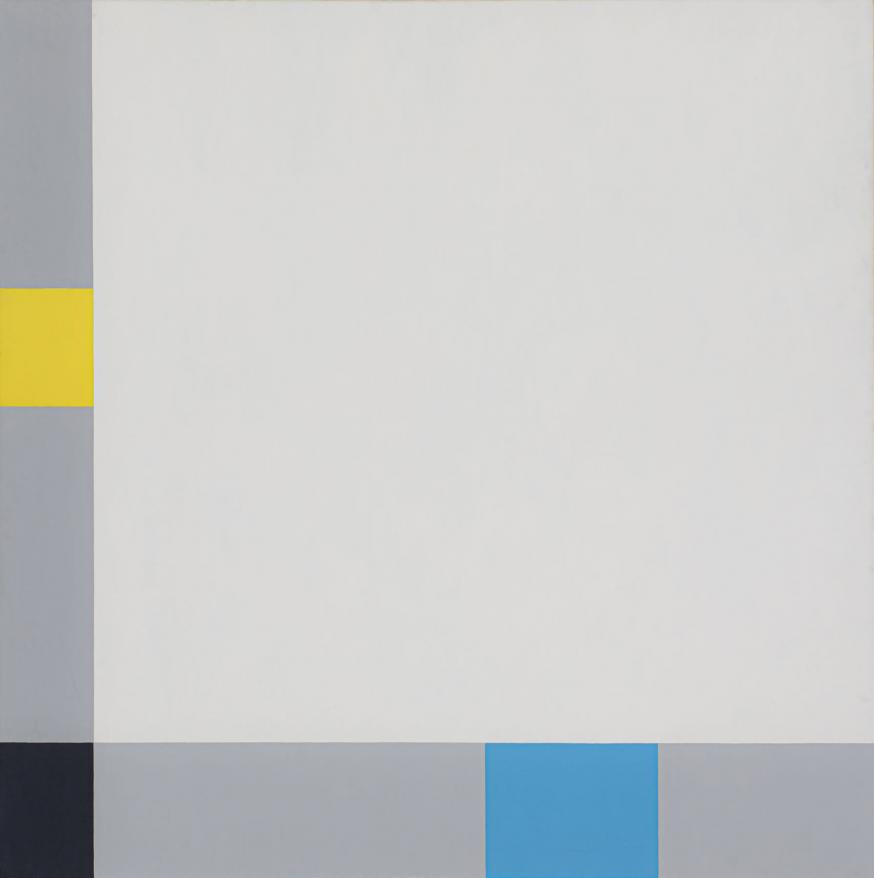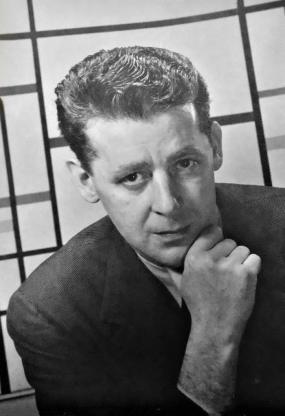Burgoyne Diller
1906–1965


Burgoyne Diller with Third Theme (1946–1948); Courtesy of the Estate of Burgoyne Diller
All artworks displayed above are currently available. To inquire about additional works available by this artist, please contact the gallery.
Biography
I am attempting to feel the oneness of all…to wipe out the heritage of isolation—it is a lie man can no more isolate himself than can he isolate a molecule of matter—Not until I can achieve this knowledge of unity in its entirety—Do I feel that I can truly express the forces I feel myself in and a part of.
A pioneer of American modernism, Burgoyne Diller devoted his career to the exploration of geometric abstraction in painting, drawing, collage, and sculpture. Diller is known for bringing the neo-plastic principles of artists such as Piet Mondrian to the United States, as well as for being the head of the Mural Division in the New York City section of the Federal Art Project.
Born in the Bronx in 1906, when the borough was still rural, Diller had a difficult childhood. His father died when he was only three, and in 1919, after his mother remarried, the family moved to Battle Creek Michigan. A childhood illness caused Diller to miss a year of school, and during that time, he began to draw. Diller exhibited a natural talent for art, and after graduating from Michigan State College in 1927, Diller moved back to New York City in 1928. From 1928 to 1933, Diller supported himself while studying at the Art Students League with Jan Matulka, George Grosz, and Hans Hofmann. While there he created “paintings and drawings . . . dominated by biomorphic sculptural forms floating in space.”[1]
In the early 1930s, Diller began a long career with the various incarnations of the Works Progress Administration (WPA), which became a vital way for him to support himself as an artist. In 1934, he served as Supervisor for Mural Painting for the Temporary Emergency Relief Administration (TERA). When TERA was terminated the following year, Diller remained a supervisor for mural painting, but under the newly formed Federal Art Project (FAP) of the WPA. He held this position until 1940. During his tenure at the WPA, Diller championed abstract art and oversaw the execution of more than 200 public murals, most of which were completed as part of his largest undertaking: in the late 1930s, he supervised the artwork for the Williamsburg Housing Project in Brooklyn (1937-1939). Among the principal artists Diller selected for this project were Jan Matulka, Stuart Davis, and Paul Kelpe, who were all permitted to execute their own designs.[2] With the entry of the United States into World War II, areas of the WPA were transferred to the War Service Division, and from 1941 until 1943, Diller directed the New York City War Service Art Project. When the Project was terminated in 1943, Diller joined the Navy, serving on active duty until the end of the war in 1945. During these two years, he stopped creating art altogether.
For Diller, abstraction was “the ideal realm of harmony, stability and order in which every form and spatial interval could be controlled and measured.” He was a founding member of the American Abstract Artists group and a participant in their first exhibition at the Squibb Gallery (1937), but his affiliation with the group was short-lived. In the early 1930s, Diller’s art evolved from cubism to non-objective neoplasticism. He simplified his palette to the bold colors and black and white of neoplasticism and reduced his visual vocabulary to squares and rectangles. No slavish imitator of Mondrian, Diller developed a highly personal language based on three major compositional themes. These themes, which he labeled “First,” “Second,” and “Third,” explored the picture plane in relation to forms in movement and/or forms in “constant opposition.” Diller translated these themes into three dimensions as well. In the early 1940s, he began creating wall-mounted wood constructions, and during the 1950s and 1960s his sculptures developed into the large-scale, free-standing, Formica works for which he is well known.
After the war, Diller re-immersed himself in art, resuming his activity in painting, drawing, and sculpture. In 1946, he began a long teaching career at Brooklyn College, and that same year, he had his first solo exhibition in over a decade, when Rose Fried mounted a show of his work at her New York City gallery, the Pinacotheca. However, his output became sporadic in the 1950s due to “mounting personal problems, excessive alcohol consumption, and a sense of rejection by an art world dominated by Abstract Expressionists,” and his exhibitions became fewer and farther between.[3] Adding to Diller’s troubles was the fact that in 1959, his studio flooded. Of the artwork he had stored in the basement, nothing could be salvaged.
Diller died in 1965, leaving behind a significant body of work that includes painting, drawing, collage, and sculpture. His work testifies not only to his versatility as an artist, but also to his unique ability to “[personalize] the international language of Neo-Plasticism and [instill] his simplified geometric compositions with emotion, spirituality, and a sense of the heroic.”[4] As Philip Larson has noted, Diller’s work serves as a vital link between American abstraction of the 1930s and minimalism of the 1950s and 1960s epitomized by artists Donald Judd, Ellsworth Kelly and Myron Stout.[5] Over the years his work has been exhibited internationally, most notably his 1990 retrospective organized by the Whitney Museum of American Art. His work is represented in numerous museum collections including the Art Institute of Chicago, Solomon R. Guggenheim Museum, Metropolitan Museum of Art, and Museum of Modern Art.
[1] Michael Rosenfeld, “Burgoyne Diller and the Third Dimension,” Burgoyne Diller: The Third Dimension: Sculpture and Drawings. 1930-1965, exh. cat., (New York: Michael Rosenfeld Gallery, November 1997), np.
[2] Ina Prinz, Drawings and Collages by Burgoyne Diller: Pioneer of Minimalism, exh. cat. (New York: Spanierman Gallery, October 6, 2011), 5.
[3] Rosenfeld, np.
[4] Rosenfeld, np.
[5] Philip Larson, Burgoyne Diller, Paintings, Sculptures, Drawings, exh. cat., (Minneapolis: Walker Art Center, 1971), 15.
Gallery Exhibitions
Publications

